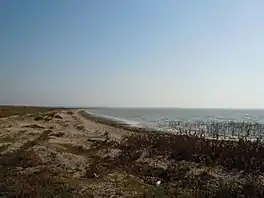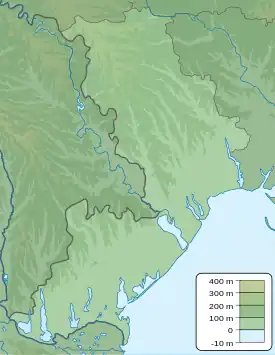| Sasyk Lagoon | |
|---|---|
 The coast of Sasyk Lagoon near Hlyboka village | |
 | |
 Sasyk Lagoon  Sasyk Lagoon | |
| Location | Black Sea |
| Coordinates | 45°38′37″N 29°39′27″E / 45.64361°N 29.65750°E |
| River sources | Cogâlnic River, Sarata River |
| Ocean/sea sources | Atlantic Ocean |
| Basin countries | Ukraine |
| Surface area | 215 km2 (83 sq mi) |
| Average depth | 1.05 m (3.4 ft) |
| Max. depth | 3.3 m (11 ft) |
| Settlements | Tatarbunary |
| Official name | Sasyk Lake |
| Designated | 23 November 1995 |
| Reference no. | 762[1] |
Sasyk, or Kunduk (Ukrainian: Сасик, Кундук – transcribed as previous, Romanian: Limanul Sasic, Conduc, Turkish: Sasık Gölü, Kunduk Gölü), is a lagoon or liman in southern Ukraine, near the Danube Delta. It is a Ramsar listed wetland site important for migrating, breeding and moulting birds. About 25,000 pairs of wetland birds make their nests there and seasonal conglomerations of birds are up to 100,000 individuals.[2]
The area of the lagoon is 215 km2, and the depth up to 3.3 m. Until 1978 the lagoon was separated into two parts: northern brackishwater area, including the rivers Cogâlnic and Sarata, and a southern marine area. The lagoon was separated from the sea by a 0.5 km wide sandbar.
Dam and reduced salinity
In 1978 a concrete dam was built on the sandbar and the lagoon was connected to the Danube River by a canal, through which fresh flood waters come. This has adversely changed the salinity in the lake, and this plus disturbances from recreation and commercial fishing activities have influenced the habitat for wildfowl.[2]
The aim of this Soviet dam project was to convert the lagoon to a fresh water lake to use for irrigation. However, this failed and the use of water from Sasyk resulted in the salinization of about 30,000 hectares (300 km2) of land, with associated detrimental impact on crops, and mineralization of ground water and wells.[3] The project ended in ecological, social and economic disaster.[4]
A 2007 report stated that the lagoon had become too dangerous for swimming because of pollution, including pesticides and heavy metals. The water is described as greenish with an unpleasant smell.[4][5] Many now favour breaking the dam and reconnecting the lagoon with the sea.[4][5]
In 2022, Ukrainian-American filmmaker Andrea Odezynska's documentary film "Return Sasyk To The Sea" was released, detailing the history of the region and efforts to restore the damaged wetlands.
Notes and references
- ↑ "Sasyk Lake". Ramsar Sites Information Service. Retrieved 25 April 2018.
- 1 2 "Information Sheet on Ramsar Wetlands: Sasyk Lake"
- ↑ Anna Onisimova (21 January 2016). "Women Transform the Mainstream" (PDF). MAMA-86. p. 38. Retrieved 24 June 2017.
- 1 2 3 Chantal van den Bossche (14 August 2008). "Give Sasyk back to the sea!". WECF International. Retrieved 25 June 2017.
- 1 2 Anna Samwel, WECF (22 August 2007). "Tatarbunary, Odessa Oblast, Ukraine – Partner visit to Mama-86 and Vozrozhdeniye in the frame of the Empowerment & Local Action/MFS Program" (PDF). Retrieved 24 June 2017.